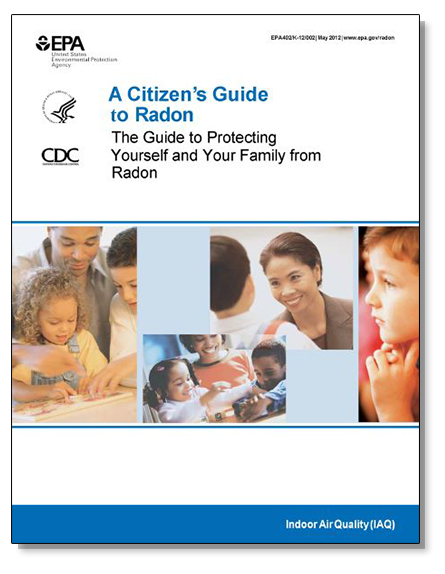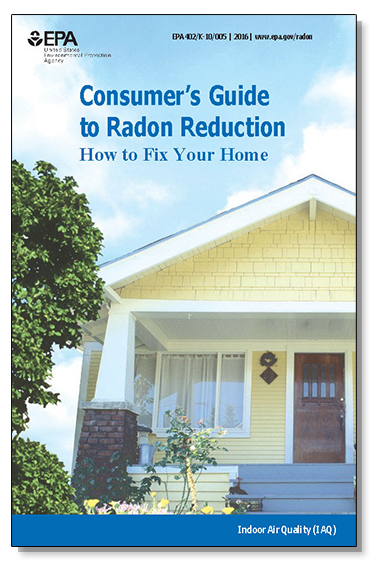Test for Radon
When Should You Test?
On average, radon concentrations in Texas are lower than other parts
of the United States, but concentrations of radon in Texas residences
can still exceed the EPA limit of 4 pCi/L. It is recommended that all homes be tested for radon to ensure a healthy, indoor air environment.
How Can I Test for Radon?
There are two principal radon testing methods for home use. Most
indoor radon tests are short-term tests performed using simple activated charcoal canister kits. These tests passively absorb small
amounts of radon over 3-7 days, and the canister is subsequently
analyzed by an EPA-approved lab. Kits are available from local
hardware stores for approximately $15-$25, or you may request a free radon test kit, depending on where you live. You may also purchase test kits online from numerous
private companies or through the National Radon Program Services.
The other method is a long-term (one month-one year) alpha-track
test that detects radiation from radon and is then analyzed by an EPA-
approved lab. Long-term tests are generally recommended when results from short-term
tests show radon values between 4 and 8 pCi/L. Long-term tests are also available
from local hardware stores but are more costly.
The Texas Radon Group offers free radon test kits for Texas individuals who qualify.
Using a Radon Test Kit
Radon testing kits are easy to use, but it’s important that you follow
the guidelines that come with the kits, as instructions vary with type.
Short-term home testing kits are typically placed in a home for 2-7
days, depending on type, before they are sealed and mailed to a
certified laboratory for analysis; long-term tests require 90+ days.
"A Citizen’s Guide to Radon" is an EPA publication that describes in detail where to place home radon tests, but a few general guidelines are provided below.
- Always follow the instructions that come with your test kit.
- If you are doing a short-term test, close your windows and outside doors and keep them closed as much as possible during the test.
- If you are doing a short-term test lasting just 2 or 3 days, be sure to close your windows and outside doors at least 12 hours before beginning the test too.
- You should not conduct short-term tests lasting just 2 or 3 days during unusually severe storms or periods of unusually high winds.
- The test kit should be placed in the lowest lived-in level of the home (for example, the basement if it is frequently used, otherwise the first floor).
- Radon test kits should not be placed in kitchens, bathrooms, or on granite countertops. This may result in radon readings that are unreliable and/or unnaturally high, as described below.
- Place the kit at least 20 inches above the floor in a location where it won’t be disturbed—away from drafts, high heat, high humidity, and exterior walls.
Granite Countertops and Radiation
Recent news stories have raised concerns about the possibility of
radiation coming from granite countertops.
Granite, as with other kinds of rocks and soils, contains some naturally
occurring radioactive elements commonly referred to as Naturally
Occurring Radioactive Material (NORM). NORM is made of elements such as thorium, uranium,
and potassium, which contribute to "background" radiation. This background radiation
is a combination of terrestrial and cosmic radiation that individuals are continuously
exposed to in their normal life. On average, Texans receive about 300 millirem (unit
of ionizing radiation) each year from these sources. In comparison, a person might
receive approximately 20 millirem from a routine chest x-ray.
The amount of radioactivity in most granite is moderately small. While it is possible
to detect a measurable level of direct radiation from some
granite, it generally emits less radiation than we are regularly exposed
to from background radiation. These levels are so low that they are not
harmful to human health. However, millirems and pCi are both units of radioactivity,
and the emission of background radiation very close to a test kit will lead to results
that are artificially elevated. For this reason, it is best not to test on surfaces
like granite.
Basement Concerns
Basements typically have higher levels of radon than the rest of the home. Radon can enter a home through sources like concrete foundations or exposed earth, making basements a viable source of entry. Additionally, temperature and pressure differences between basements and the surrounding soils can lead to increased migration of radon into basements compared with houses that do not have basements.
Radon test kits should be placed in the lowest lived-in level of the home. If a basement is frequently used for recreation (for instance, as a den or playroom), a test kit should be administered in this level; If basement use is minimal (such as for laundry), the test should be placed in the first floor of the home.
Further Action
There are many reasons for elevated radon concentrations. The two most common reasons include:
- Winter testing. Radon concentrations are most likely to be elevated during the cold winter months when home heating systems are in high use.
- Granite Countertops. (Described above.) Avoid placing radon test kits on granite countertops.
If radon concentrations from a short-term test in your home exceed 4 pCi/L, it’s best to run a second test using either a second short-term or a long-term test. A long-term test is recommended for radon concentrations between 4 and 8 pCi/L. A second short-term test recommended for radon concentrations exceeding 8 pCi/L. This procedure is described in detail in "A Citizens Guide to Radon."
Some owners opt to have an inspector test or re-test their home. There are no radon certification requirements for the State of Texas at this time for testers, but the National Radon Proficiency Program lists radon testers and mitigators within Texas that have passed a rigorous national certification program. A list of these individuals can be found at NRPP. Local home inspectors in your area may also perform radon testing.
If the average of the two short-term tests and/or results from a long-term test exceed 4 pCi/L, the EPA recommends that homeowners should take action, and you may need to consider a radon mitigation system. More information can be found in the EPA document, "Consumer's Guide to Radon Reduction" and in Elevated Radon Action.
Radon
-
Address
911 Boston Ave | Box 41023 | Lubbock, TX 79409-1023 -
Phone
806.834.0370 -
Email
kayleigh.millerick@ttu.edu


